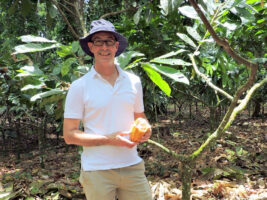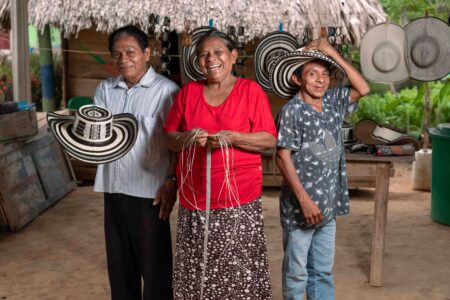Exclusive: Creating ingredients for success at Nestlé’s UK facilities

pic: Nestle
Delivering on ambitious flavour and taste goals is a demanding, yet rewarding task, as Neill Barston discovers, speaking to Nestlé cocoa ingredient advisor John Newell, based at the company’s York manufacturing site, home to its flagship KitKat brand.
The world of ingredients development for confectionery is an extremely complex and dynamic one that continues to pose a wealth of challenges for businesses pushing the boundaries of the sector.
One thing is for sure, the segment’s considerable value has made it a prized area of the industry, with forecasts from Allied Market Research placing the category’s overall value to be worth a total of $475 billion by the end of the decade. (see our video interview with John here).
Creating ingredients for success Given the sheer sums at stake, it’s little wonder that many confectionery companies remain notably protective of their proprietary processes and recipes behind some of the leading brands making their way to shelves around the world. Nestlé is no exception to that rule, and in truth, it’s probably a key reason behind the business building its pathway to becoming regarded as the largest food group operating in the world today. There are, of course, particular challenges that are impacting on the broader sector this year, including supply chain disruptions from the ongoing Ukrainian war, resulting in higher ingredients that is impacting on businesses across the world.
However, it seems the Swiss-headquartered global firm appears to be weathering the storm comparatively well, if its continued rate of production creation is anything to go by. Clearly, there’s no room for complacency, as Dr John Newell, corporate ingredient advisor for cocoa at the company’s York operations reveals, it’s a role that requires a strong technical grasp of core processing principles, coupled with an inquisitive nature for exploring the horizons of taste and flavour to meet consumers’ ever evolving expectations.
As the US-born expert, who holds a degree in microbiology, reveals, there are certainly notable tests in his role as part of the company’s wider product development work, yet after more than twenty years working for Nestlé across its Swiss, and more recently, UK, operations, he says it remains particularly rewarding.
“We’re always looking for new ways to excite consumers – some are happy with the same products that they don’t want to change at all. Such as the classic KitKat, which they love. But others are looking out for new taste and texture experiences, such as natural, and authentic flavours, and an interesting or inspiring story. First of all, it’s taste that is most important – if it doesn’t taste good, a product won’t go anywhere,” he notes of the company’s approach to creating its ranges.
Notably, in a competitive industry, there’s always a certain amount of pressure to deliver the ‘next big’ thing, but Nestlé, like many of the big five or six operators, has continued to place high value in its research and development teams.
Which is precisely where experts such as John fit in, through working with experts both regionally, as well as internationally, to ensure the business is on the front foot when it comes to seeking out new innovations.
While the company as a whole has most notably placed a large marker down for a central focus on devising health and nutrition-based product ranges, confectionery, and the ingredients behind them, are still significant to its global operations.
“My role is focused on cocoa liquor and cocoa beans, and part of that is managing specifications, as well as involving giving technical assistance to our factories.
“There’s also a component of innovation, which is really important for building our business. This includes developing and optimising processes and products as well. So, for me the part I find really interesting and am passionate about is making the connection between the ingredients that we’re using, what their characteristics are, and how those change through the processes you use – either fermentation, cooking or flavour development, and the products that you get out of it at the end as far as the products are concerned,” adding that the early years of his career within fundamental science projects formed a strong basis to expand his interest into applying that acquired knowledge for shifting his focus into the development of products.

As he enthuses, while Nestlé has a series of dedicated R&D sites across its portfolio of operations, there’s something pretty special being based at the company’s York site, which traces its heritage back to its original days dating back to the 1860’s under its former guise as Rowntree’s.
Having such a renowned heritage in what has been widely regarded as the UK’s capital of chocolate – complete with its own city museum dedicated to confectionery history, serves as a notably motivating force for those working in the sector.
“Part of my journey to more applied research has been my passion for food, and confectionery, whether that’s pastries or chocolate, or cakes, so when I moved from my role in Switzerland to the UK, it was the most logical next step for me to be in York – which is the home of chocolate research and development within Nestlé,” enthuses John.
“As a company, our research centres offer a really great environment, as we have a good critical mass of expertise in the business. In York, we have a chocolate department, a wafer department, and engineers, pilot plant, kitchen, sensory and design team. “So, from a product perspective that’s great as you can do everything from the initial development work and designing of packaging and other processes, coming through to the finished product and handing that over to our factories,” states John, who acknowledges that having such a fine degree of in-house competencies offers a distinct advantage to the business in terms of new product development.
Centre for product creativity
As Confectionery Production discovered while on a previous site visit to the company’s visit to the city – which is home to the company’s KitKat production, there’s a whole host of innovation and development being forged. With the company turning out over a billion of the bars of the flagship chocolate brand a year from the site, it remains a confectionery staple, beloved by Brits as much as many other nationalities.
Thankfully, for long-term fans of the former Rowntree’s product lines, there’s also been a strong sense that as well as forging new product series, maintaining some old classics is very much in order from the York manufacturing base.
This has been in evidence with the likes of Milky Bar and Aero living on after the company bought the much-loved business for reported fee of $4.5 billion back in1988, further cementing its place as a major global confectionery player. As far as KitKat is concerned, it retains its global standing through advances in ingredients with a dizzying array of flavours. This is perhaps most readily seen within Japan, where Tokyo Banana, Wasabi and Matcha Green tea have taken hold among many other regional specialities. The past five years has also seen the development of the much-heralded Ruby KitKat KitKat, hailed as the ‘fourth type of chocolate’, which drew media headlines around the world in the wake of its decisive partnership with Barry Callebaut.
Five years on from its release, and the product range has morphed into many other segments, including being used within ice cream through other brands, as consumers continue to embrace its sweet raspberry taste profile.
As he discusses his complex role, John says there are a number of day-to-day challenges, and tests that have proved particularly rewarding, and its ambitious programme of development has kept him fully engaged during the past decade based in the UK. “With our facilities at York for our product and process side, we’re pushing things to the limit – we do things that are completely new, we are not there to do simple swaps of flavour, but much more challenging things. “An example would be a few years ago, we invented the world’s first 70 per cent dark chocolate (Incoa) made from nothing more than what is inside the cocoa pod, which was groundbreaking.

It was a demonstration of what we can do as a company,” says the expert, who noted there had been a high degree of technical challenge to process cocoa pulp, including drying it, to deliver a sustainability-focused product that made full use of the cacao fruit, two third of which had conventionally gone to waste beyond the use of pure beans. It’s an area that several companies have capitalised on now, which has both environmental benefits, as well as a spin-off of potentially meaning a higher price paid to farmers in the sector. – For the full, extended version of the feature, see our latest edition of the magazine.



